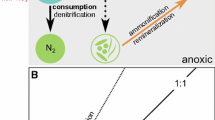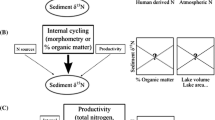Abstract
Nitrogen stable isotope (δ15N) data of particulate organic matter (POM) from the literature were analyzed to provide an understanding of the variations and controls of δ15NPOM in lakes at the global scale. The δ15NPOM variability characterized by seasonal mean, minimum, maximum, and amplitude (defined as δ15NPOM maximum − δ15NPOM minimum) from 36 lakes with seasonal data did not change systematically with latitude, but was significantly lower in small lakes than in large lakes. The seasonal mean δ15NPOM increased from oligotrophic lakes to eutrophic lakes despite large variations that are attributed to the occurrences of nitrogen fixation across the trophic gradient and the differences in δ15N of dissolved inorganic nitrogen (DIN) in individual lakes. Seasonal mean δ15NPOM was significantly correlated with DIN concentration and δ15NDIN in two subsets of lakes. Seasonal minimum δ15NPOM in individual lakes is influenced by nitrogen fixation and δ15NDIN while seasonal maximum δ15NPOM is influenced by lake trophic state and δ15NDIN. As a result of the dominance of non-living POM in the unproductive surface waters, seasonal δ15NPOM amplitude was small (mean = 4.2‰) in oligotrophic lakes of all latitudes. On the other hand, seasonal δ15NPOM amplitude in eutrophic lakes was large (mean = 10.3‰), and increased from low to high latitudes, suggesting that the seasonal variability of δ15N in the phytoplankton-dominated POM pool was elevated by the greater spans of solar radiation and thermal regimes at high latitudes. The δ15NPOM from 42 lakes with no seasonal data revealed no consistent patterns along latitude, lake area, and trophic gradients, and a greater than 2‰ depletion compared to the lakes with seasonal data. Along with the large seasonal variability of δ15NPOM within lakes, these results provide insightful information on sampling design for the studies of food web baseline in lakes.







Similar content being viewed by others
References
Anderson C, Cabana G (2005) δ15N in riverine food webs: effects of N inputs from agricultural watersheds. Can J Fish Aquat Sci 62:333–340
Bade DL, Carpenter SR, Cole JJ, Hanson PC, Hesslein RH (2004) Controls of δ13C-DIC in lakes: geochemistry, lake metabolism, and morphometry. Limnol Oceanogr 49:1160–1172
Bootsma HA, Hecky RE, Hesslein RH, Turner GF (1996) Food partitioning among Lake Malawi nearshore fishes as revealed by stable isotope analyses. Ecology 77:1286–1290
Cabana G, Rasmussen JB (1996) Comparison of aquatic food chains using nitrogen isotopes. Proc Natl Acad Sci USA 93:10844–10847
Carpenter SR, Caraco NF, Correll DL, Howarth RW, Sharpley AN, Smith VH (1998) Nonpoint pollution of surface waters with phosphorus and nitrogen. Ecol Appl 8:559–568
Chapman AD, Schelske CL (1997) Recent appearance of Cylindrospermopsis (Cyanobacteria) in five hypereutrophic Florida lakes. J Phycol 33:191–195
Delwiche CC, Steyn PL (1970) Nitrogen isotope fractionation in soils and microbial reactions. Environ Sci Technol 4:929–935
Elser JJ, Bracken MES, Cleland EE, Gruner DS, Harpole WS, Hillebrand H, Ngai JT, Seabloom EW, Shurin JB, Smith JE (2007) Global analysis of nitrogen and phosphorus limitation of primary producers in freshwater, marine and terrestrial ecosystems. Ecol Lett 10:1135–1142
Estep MLF, Vigg S (1985) Stable carbon and nitrogen isotope tracers of trophic dynamics in natural populations and fisheries of the Lahontan Lake system, Nevada. Can J Fish Aquat Sci 42:1712–1719
Goericke R, Montoya JP, Fry B (1994) Physiology of isotopic fractionation in algae and cyanobacteria. In: Lajtha K, Michener RH (eds) Stable isotopes in ecology and environmental science. Blackwell, Oxford, pp 187–221
Goldman CR, Marzolf ER, Elser JJ (1990) Phosphorus and nitrogen limitation of phytoplankton growth in the freshwaters of North America: a review and critique of experimental enrichments. Can J Fish Aquat Sci 47:1468–1477
Gondwe MJ, Guildford SJ, Hecky RE (2008) Planktonic nitrogen fixation in Lake Malawi/Nyasa. Hydrobiologia 596:251–267
Gu B (1993) Natural abundance of 15N in a subarctic lake and biogeochemical implications to nitrogen cycling. Dissertation, University of Alaska-Fairbanks
Gu B, Alexander V (1993) Estimation of N2 fixation based on differences in the natural abundance of 15N among freshwater N2-fixing and non-N2-fixing algae. Oecologia 96:43–48
Gu B, Schell DM, Alexander V (1994) Stable carbon and nitrogen isotopic analysis of the plankton food web in a subarctic lake. Can J Fish Aquat Sci 51:1338–1344
Gu B, Schelske CL, Brenner M (1996) Relationship between sediment and plankton isotope ratios (δ13C and δ15N) and primary productivity in Florida lakes. Can J Fish Aquat Sci 53:875–883
Gu B, Chapman AD, Schelske CL (2006) Factors controlling seasonal variations in stable isotope composition of particulate organic matter in a soft water eutrophic lake. Limnol Oceanogr 51:2837–2848
Hadas O, Altabet MA, Agnihotri R (2009) Seasonally varying nitrogen isotope biogeochemistry of particulate organic matter in Lake Kinneret, Israel. Limnol Oceanogr 54:75–85
Harvey CJ, Kitchell JF (2000) A stable isotope evaluation of the structure and spatial heterogeneity of a Lake Superior food web. Can J Fish Aquat Sci 57:1395–1403
Havens KE, Phlips EJ, Cichra MF, Li B (1998) Light availability as a possible regulator of cyanobacteria species composition in a shallow subtropical lake. Freshw Biol 39:547–556
Hodell DA, Schelske CL (1998) Production, sedimentation, and isotopic composition of organic matter in Lake Ontario. Limnol Oceanogr 43:200–214
Hoering TC, Ford HT (1960) The isotope effect in the fixation of nitrogen by Azotobacter. J Am Chem Soc 82:376–378
Jäntti H (2007) The spatial and temporal variation of nitrogen fixation in aquatic environments. Master Thesis, University of Jyväskylä
Kling GW, Fry B, O’Brien WJ (1992) Stable isotopes and planktonic trophic structure in Arctic lakes. Ecology 73:561–566
Leavitt PR, Brock CS, Ebel C, Patoine A (2006) Landscape-scale effects of urban nitrogen on a chain of freshwater lakes in central North America. Limnol Oceanogr 51:2262–2277
Lehmann MF, Bernasconi SM, McKenzie JA, Barbieri A, Simona M, Veronesi M (2004) Seasonal variation of the δ13C and δ15N of particulate and dissolved carbon and nitrogen in Lake Lugano: constraints on biogeochemical cycling in a eutrophic lake. Limnol Oceanogr 49:415–429
MacGregor BJ, Van Mooy B, Baker BJ, Mellon M, Moisander PH, Paerl HW, Zehr J, Hollander D, Stahl D (2001) Microbiological, molecular biological and stable isotopic evidence for nitrogen fixation in the open waters of Lake Michigan. Environ Microbiol 3:205–219
McCusker EM, Ostrom PH, Ostrom NE, Jeremiason JD, Baker JE (1999) Seasonal variation in the biogeochemical cycling of seston in Grand Traverse Bay, Lake Michigan. Org Geochem 30:1543–1557
Minagawa M, Wada E (1986) Nitrogen isotope ratios of red tide organisms in the East China Sea: a characterization of biological nitrogen fixation. Mar Chem 19:245–259
Montoya JP, McCarthy JJ (1995) Isotopic fractionation during nitrate uptake by phytoplankton grown in continuous culture. J Plankton Res 17:439–464
Montoya JP, Carpenter EJ, Capone DG (2002) Nitrogen fixation and nitrogen isotope abundances in zooplankton of the oligotrophic North Atlantic. Limnol Oceanogr 47:1617–1628
Mooy BV, MacGregor B, Hollander D, Nealson K, Stahl D (2001) Evidence for tight coupling between active bacteria and particulate organic carbon during seasonal stratification of Lake Michigan. Limnol Oceanogr 46:1202–1208
Ostrom NE, Long DT, Bell EM, Beals T (1998) The origin and cycling of particulate and sedimentary organic matter and nitrate in Lake Superior. Chem Geol 152:13–28
Owen JS, Mitchell MJ, Michener RH (1999) Stable nitrogen and carbon isotonic composition of seston and sediment in two adirondack lakes. Can J Fish Aquat Sci 56:2186–2192
Owens NJP (1987) Natural variations in 15N in the marine environment. Adv Mar Biol 24:389–451
Patoine A, Graham MD, Leavitt PR (2006) Spatial variation of nitrogen fixation in lakes of the northern Great Plains. Limnol Oceanogr 51:1665–1677
Peterson BJ, Fry B (1987) Stable isotopes in ecosystem studies. Annu Rev Ecol Syst 18:293–320
Post DM (2002) Using stable isotopes to estimate trophic position: models, methods, and assumptions. Ecology 83:703–718
Pulido-Villena E, Reche I, Morales-Baquero R (2005) Food web reliance on allochthonous carbon in two high mountain lakes with contrasting catchments: a stable isotope approach. Can J Fish Aquat Sci 62:2640–2648
Sarvala J, Badende S, Chitamwebwa D, Juvonen P, Mwape L, Molsa H, Mulimbwa N, Salonen K, Tarvainen M, Vuorio K (2003) Size-fractionated δ15N and δ13C isotope ratios elucidate the role of the microbial food web in the pelagial of Lake Tanganyika. Aq Ecosyst Health Manage 6:241–250
Savage C (2005) Tracing the influence of sewage nitrogen in a coastal ecosystem using stable nitrogen isotopes. Ambio 34:143–148
Syväranta J, Tiirola M, Jones RI (2008) Seasonality in lake pelagic δ15N values: patterns, possible explanations, and implications for food web baseline. Fundam Appl Limnol 172:255–262
Teranes JL, Bernasconi SM (2000) The record of nitrate utilization and productivity limitation provided by δ15N values in lake organic matter—a study of sediment trap and core sediments from Baldeggersee, Switzerland. Limnol Oceanogr 45:801–813
Vander Zanden MJ, Vadeboncoeur Y, Diebel MW, Jeppensen E (2005) Primary consumer stable nitrogen isotopes as indicators of nutrient source. Environ Sci Technol 39:7509–7515
Vuorio K, Meili M, Sarvala J (2006) Taxon-specific variation in the stable isotopic signatures (δ15N and δ13C) of lake phytoplankton. Freshw Biol 51:807–822
Wada E, Hattori A (1978) Nitrogen isotope effects in the assimilation of inorganic nitrogenous compounds by marine diatoms [Phaeodactylum tricornutum and Chaetoceros sp.]. Geomicrobiol J 1:85–101
Wang J, Wu F, Li W, Wang L, Guo J, Fu P, Zhang R (2008) Seasonal variation and vertical characteristics of the δ15N of particulate organic matter in Lake Hongfeng and Lake Baihua, Guizhou Province. J Lake Sci 20:571–578 (in Chinese)
Waser NAD, Harrison PJ, Nielsen B, Calvert SE, Turpin DH (1998) Nitrogen isotope fractionation during the uptake and assimilation of nitrate, nitrite, ammonium, and urea by a marine diatom. Limnol Oceanogr 43:215–224
Wetzel RG (2001) Limnology: lake and river ecosystems, 3rd edn. Academic Press, San Diego
Xie YX, Xiong ZQ, Xing GX, Sun GQ, Zhu ZL (2007) Assessment of nitrogen pollutant sources in surface waters of Taihu Lake region. Pedosphere 17:200–208
Yoshioka T, Wada E, Saijo Y (1988) Isotopic characterization of Lake Kizaki and Lake Suwa. Jpn J Limnol 49:119–128
Yoshioka T, Wada E, Hayashi H (1994) A stable isotope study on seasonal food web dynamics in a eutrophic lake. Ecology 75:835–846
Acknowledgments
I appreciated the critical comments by two anonymous reviewers and the editorial improvements by Dr. Thomas Dreschel and Dr. Sharon Ewe.
Author information
Authors and Affiliations
Corresponding author
Additional information
Communicated by Ulrich Sommer.
Electronic supplementary material
Below is the link to the electronic supplementary material.
Rights and permissions
About this article
Cite this article
Gu, B. Variations and controls of nitrogen stable isotopes in particulate organic matter of lakes. Oecologia 160, 421–431 (2009). https://doi.org/10.1007/s00442-009-1323-z
Received:
Accepted:
Published:
Issue Date:
DOI: https://doi.org/10.1007/s00442-009-1323-z




